The Dell PowerEdge R7615 is a feature-rich enterprise 2U single-socket server specifically catering to those seeking a balance between cost-effectiveness and robust performance, making it a compact yet powerful choice for various data center applications.
What stands out is its adoption of the 4th Generation AMD EPYC 9004 Series processor, released earlier this year, offering processors with up to 128 cores and promising exceptional speed and efficiency for data-intensive tasks. The server’s memory capabilities are equally impressive, supporting up to 3TB of DDR5 RAM, ensuring high-speed data processing and multitasking ease.
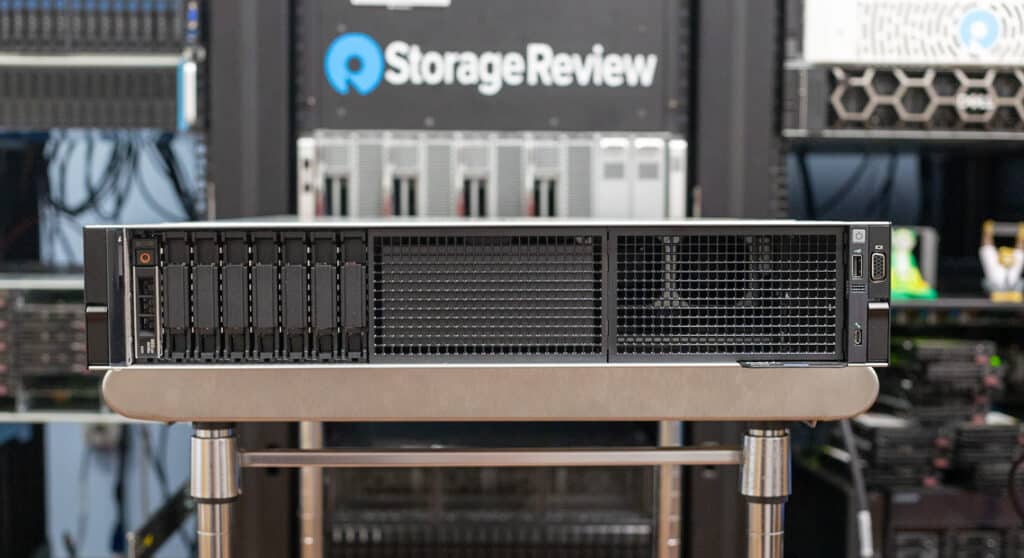
On the storage front, the PowerEdge R7615 offers extensive options, with configurations ranging from 8 to 32 drive bays supporting a variety of HDDs and SSDs, allowing for up to 368.64TB of storage. This flexibility in storage solutions and the server’s support for various hot-swap redundant power supply options like the 2400W Platinum and 1800 W Titanium make it a versatile choice for diverse IT environments. Moreover, the server includes options for air cooling and the more efficient solution for high-performance processors, Direct Liquid Cooling (DLC), especially in demanding workloads.
Dell PowerEdge R7615 Available Components
The Dell PowerEdge R7615 offers various CPU options for diverse computing needs. The Dell PowerEdge R7615 provides a broad range of CPU options to cater to different performance and budget requirements, from 16-core models suitable for entry-level tasks to the formidable 128-core variants designed for the most demanding workloads.
The entry-level R7615 features options like the AMD EPYC 9224 with 24 cores and a 2.50GHz clock speed, making it a cost-effective choice for moderate workloads. Mid-range options like the AMD EPYC 9354 offer 32 cores at a higher 3.25GHz clock speed, suitable for more demanding applications. The AMD EPYC 9754 stands out for users requiring ultimate performance with 128 cores and 2.25GHz speed. This range, from the 16-core AMD EPYC 9174F to the high-end models like the 96-core AMD EPYC 9654P, illustrates the server’s capability to handle anything from basic tasks to complex, data-intensive processes.
Here’s a summary of the CPU options available:
- Low-End (16 cores)
- AMD EPYC 9174F: 4.10GHz, 16C/32T, 256M Cache, 320W, DDR5-4800
- AMD EPYC 9184X: 3.55GHz, 16C/32T, 768M Cache, 320W, DDR5-4800
- Mid-Range Options
- AMD EPYC 9224: 2.50GHz, 24C/48T, 64M Cache, 200W, DDR5-4800
- AMD EPYC 9254: 2.90GHz, 24C/48T, 128M Cache, 200W, DDR5-4800
- AMD EPYC 9274F: 4.05GHz, 24C/48T, 256M Cache, 320W, DDR5-4800
- AMD EPYC 9334: 2.70GHz, 32C/64T, 128M Cache, 210W, DDR5-4800
- AMD EPYC 9354: 3.25GHz, 32C/64T, 256M Cache, 280W, DDR5-4800
- High-End (48 cores and above)
- AMD EPYC 9454: 2.75GHz, 48C/96T, 256M Cache, 290W, DDR5-4800
- AMD EPYC 9474F: 3.60GHz, 48C/96T, 256M Cache, 360W, DDR5-4800
- AMD EPYC 9534: 2.45GHz, 64C/128T, 256M Cache, 280W, DDR5-4800
- AMD EPYC 9554: 3.10GHz, 64C/128T, 256M Cache, 360W, DDR5-4800
- AMD EPYC 9634: 2.25GHz, 84C/168T, 384M Cache, 290W, DDR5-4800
- AMD EPYC 9654: 2.40GHz, 96C/192T, 384M Cache, 360W, DDR5-4800
- Top-End (128 cores)
- AMD EPYC 9684X: 2.55GHz, 96C/192T, 1150M Cache, 400W, DDR5-4800
- AMD EPYC 9734: 2.2GHz, 112C/224T, 256M Cache, 340W, DDR5-4800
- AMD EPYC 9754: 2.25GHz, 128C/256T, 256M Cache, 360W, DDR5-4800
Storage configurations in the R7615 are equally diverse, offering both NVMe, SAS, and SATA SSD options. The Dell PowerEdge R7615 is also highlighted by its integration with Dell’s PowerEdge RAID Controller (PERC) cards – specifically the PERC 11 and PERC 12 series. These controllers are essential for elevating the server’s storage reliability and performance, making the R7615 an excellent choice for businesses seeking power and efficiency.
The PERC 11 series is an earlier generation of RAID controllers, which supports a range of RAID levels – including RAID 0, 1, 5, 6, 10, 50, and 60 – catering to various needs from basic mirroring and striping to more complex nested RAID configurations. This flexibility ensures businesses can tailor their storage setup according to specific requirements for maximizing storage capacity, providing data redundancy, or achieving a balance between the two. Moreover, features like drive hot-swap support and fault tolerance are instrumental in maintaining system uptime, which is crucial for mission-critical applications.
With even more storage capabilities, the newer PERC 12 series further enhances the PowerEdge R7615 with improved performance, higher storage capacities, and support for cutting-edge storage technologies. The PERC 12’s compatibility with newer technologies, such as NVMe drives, is essential for faster data transfer rates and lower latency, a significant benefit for data-intensive applications. Additionally, this series often comes with enhanced security features like advanced encryption, providing an added layer of data protection that is increasingly essential in today’s security-conscious environment.
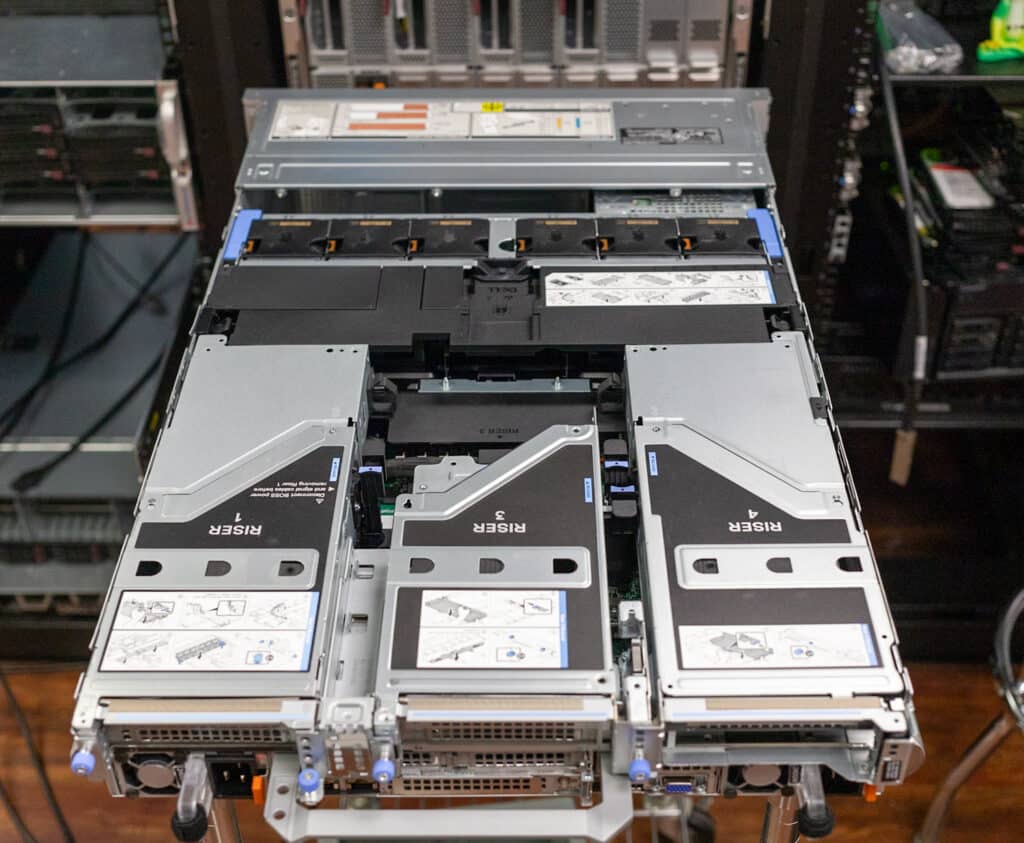
The R7615 configuration offers options for adding up to 6x single-wide full-length GPUs or 3 x double-wide full-length GPUs. NVIDIA’s L4 GPU would be a popular choice here. As an entry-level, versatile GPU, it’s ideal for inference tasks with its low power consumption, small footprint, and high performance. Of course, larger cards are also supported.
Dell PowerEdge R7615 iDRAC9 Management
The iDRAC9 interface is Dell’s out-of-band management solution, giving users advanced server management and monitoring capabilities. It allows them to deploy, monitor, update, and manage PowerEdge servers locally and remotely.
Beginning with the dashboard view, it shows a clear and concise visual representation of the server’s health, with indicators like green to signify that the system and storage components are functioning correctly. This central hub gives users critical at-a-glance information, including system details like the server model, installed operating system, and network configurations, and a summary of tasks indicating the server’s operational workload and remote management options through the virtual console.
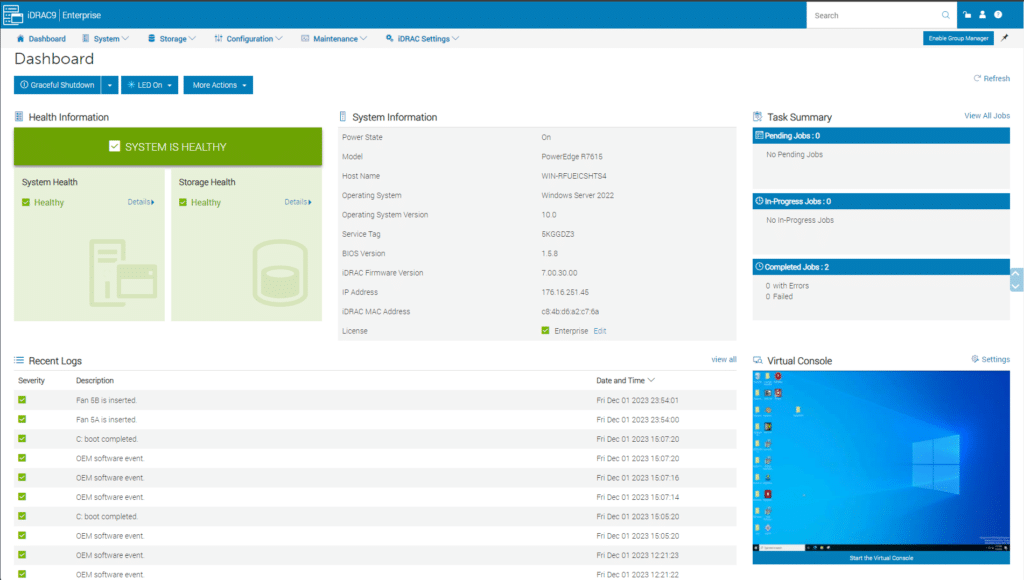
Moving on to the CPU overview, the iDRAC9’s interface offers users a deep dive into the server’s processing environment. It provides vital statistics and operational status for the CPUs, detailing speed, core counts, and other essential features like virtualization support and cache details. This area is helpful in understanding the server’s processing capabilities and ensuring CPU resources align with performance demands. Along the top of the display is easy access to other deep-dive sections, like the system’s batteries, memory, and network statistics.
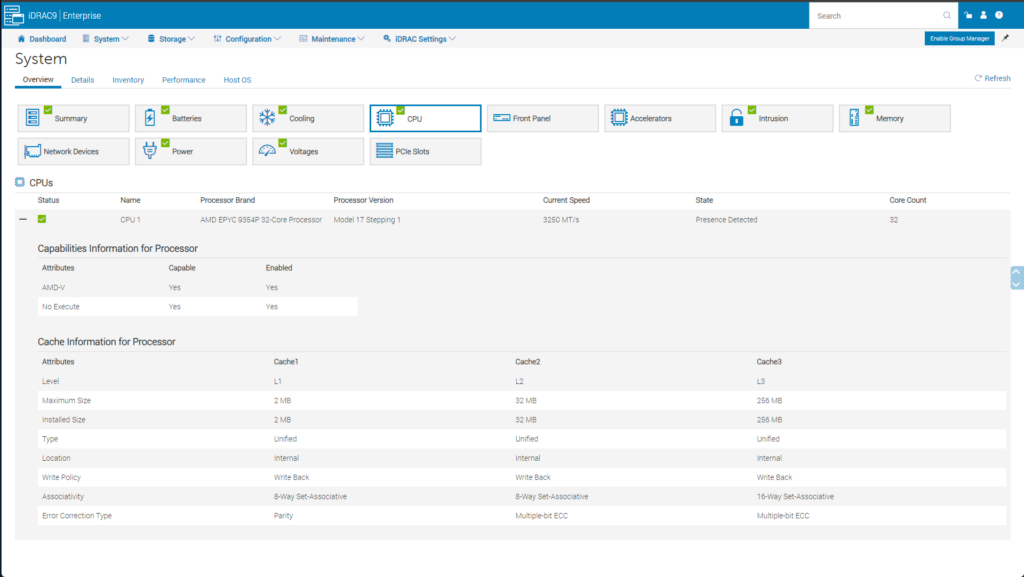
Also on that list is the Power management link, which displays detailed insights into the server’s power supply health and usage. It also delivers real-time data on power consumption (like current capacity). It tracks historical use, which is crucial for operational cost management and ensuring that the server runs within safe power thresholds.
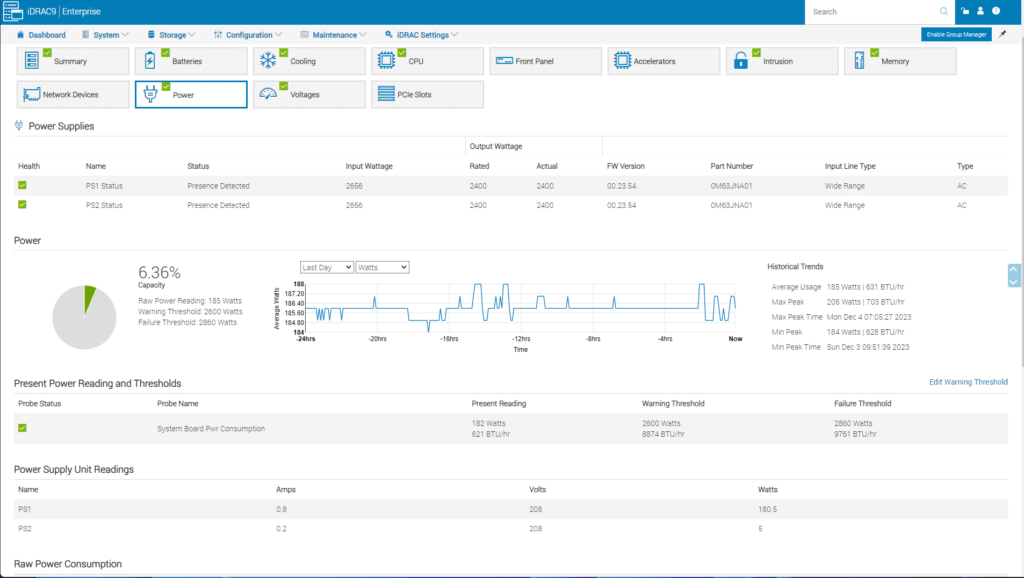
Also under the main System settings is the Performance area, where users can access a visual and interactive chart of CPU utilization. This analytic tool allows for real-time monitoring and historical performance tracking, providing valuable insights into the server’s processing efficiency over specific periods (via the drop-down list). This can be a valuable resource when you’re fine-tuning performance and identifying potential bottlenecks or periods of peak utilization.
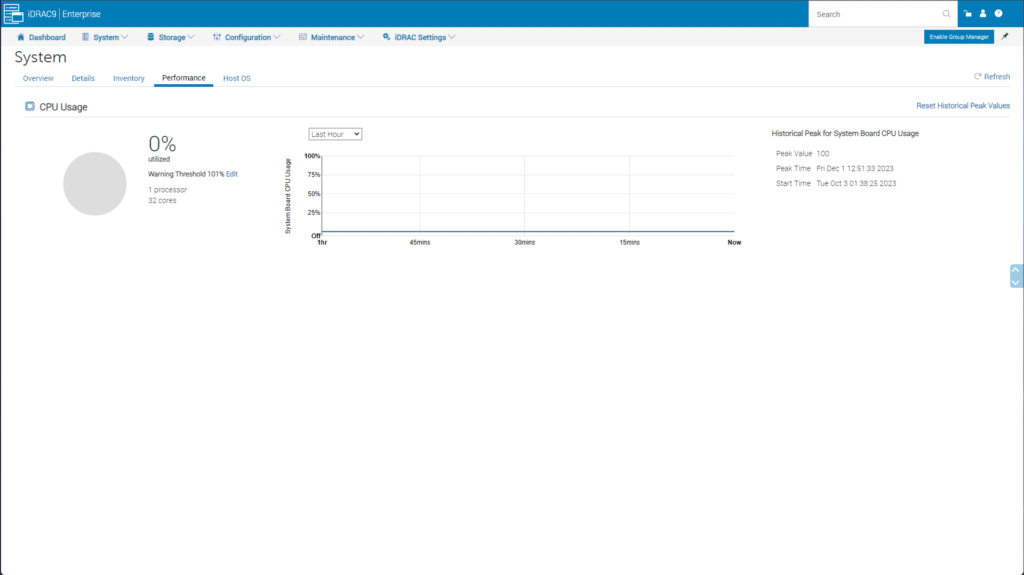
The storage area has a range section providing helpful information. The summary page offers an overview of the disk environment, showing the status of each physical disk and summarizing the RAID configuration. Below is the event log, which records all storage-related activities. This is extremely valuable for ongoing maintenance and quick troubleshooting when issues arise.
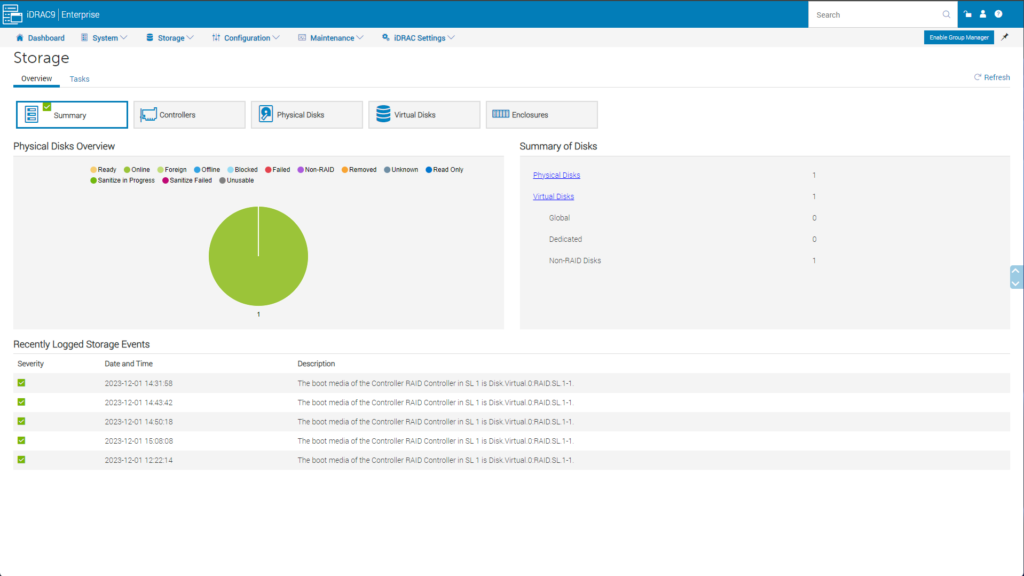
Overall, with its intuitive design and detailed reporting features, the iDRAC9 interface is a powerhouse of server management. It allows businesses to administer their Dell PowerEdge R7615 efficiently and seamlessly and equips system administrators with everything they need to maintain peak server performance and reliability.
Dell PowerEdge R7615 Review Build
The Dell PowerEdge R7615 we received for review is essentially the most basic version of what this server line can offer. It’s like the entry-level model of a high-end vehicle, stripped of its premium features yet still bearing the potential of what it could be.
As such, our review unit is powered by an AMD EPYC 9354P 32-core Processor coupled with 16GB of RAM, the latter of which is certainly less than what most consumer desktop PCs have. The server’s storage and connectivity follow this theme of simplicity. Equipped with a PERC 11 RAID card and a SATA/SAS/NVMe backplane, it offers basic yet versatile storage options. The dual 1GbE Ethernet provides standard network connectivity, suitable for everyday tasks.
Storage is handled by a single 960GB read-intensive NVMe SSD, which should provide adequate data access speeds for general purposes. Although it reflects the general theme of our server, which is sufficient for typical operations, it falls short of the full potential of R7615. The PCIe backplane, Riser Config 3, and its various slots hint at the system’s scalability. While outfitted with available slots, we do not have a GPU installed in this review build. This will undoubtedly affect how we test the R7615 in the performance section below.
In essence, this PowerEdge R7615 configuration is a glimpse into the possibilities of Dell’s server. It’s a starting point, a basic, no-frills server that gets the job done but with so much more room to grow and expand.
Dell PowerEdge R7615 Specifications
| Feature | Specification |
| Processor | One 4th Generation AMD EPYC 9004 Series processor with up to 128 cores |
| Memory | 12 DDR5 DIMM slots, supports RDIMM 3 TB max, speeds up to 4800 MT/s |
| Storage Controllers | PERC H965i, PERC H755, PERC H755N, PERC H355, HBA355i |
| Drive Bays | Front bays: Up to 32 bays with various configurations, max 368.64 TB; Rear bays: Up to 4 bays, max 61.44 TB |
| Power Supplies | 2400 W Platinum, 1800 W Titanium, 1400 W Platinum, 1100 W Titanium, 1100 W LVDC options |
| Cooling Options | Air cooling, Optional Direct Liquid Cooling (DLC) |
| Fans | High-performance Silver/Gold fans, Up to 6 hot plug fans |
| Dimensions | Height: 86.8 mm, Width: 482 mm, Depth: 772.13 mm (with bezel) |
| Form Factor | 2U rack server |
| Embedded Management | iDRAC9, iDRAC Direct, iDRAC RESTful API with Redfish, iDRAC Service Module, Quick Sync 2 wireless module |
| Bezel | Optional LCD bezel or security bezel |
| OpenManage Software | CloudIQ for PowerEdge plug-in, OpenManage Enterprise, various OpenManage Integrations |
| Security | AMD Secure Memory Encryption, Secure Boot, TPM 2.0, and other features |
| Embedded NIC | 2 x 1 GbE LOM card (optional), 1 x OCP card 3.0 (optional) |
| Network options | Various configurations, including LOM and OCP cards |
| GPU Options | Up to 3 x 300 W DW or 6 x 75 W SW |
| Ports | iDRAC Direct Micro-AB USB, USB 2.0, VGA, Serial (optional), USB 3.0 (optional) |
| PCIe Slots | Up to eight PCIe slots, including various configurations |
| Operating System and Hypervisors | Support for Canonical Ubuntu Server LTS, Microsoft Windows Server with Hyper-V, Red Hat Enterprise Linux, SUSE Linux Enterprise Server, VMware ESXi |
Dell PowerEdge R7615 Design and Build
The overall design of the PowerEdge R7615 emphasizes accessibility and ease of maintenance. Whether upgrading RAM, replacing a processor, or adding expansion cards, the server’s layout and modular design make these tasks straightforward. Users are given a wide selection of components to upgrade as their business needs grow.
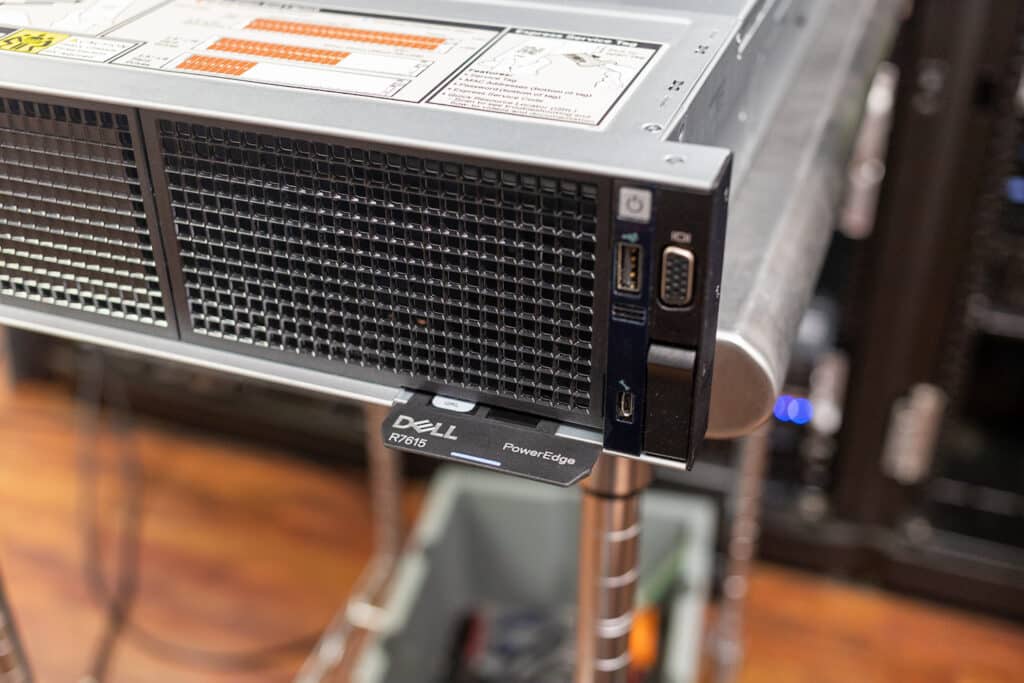
Starting at the front panel, the chassis can accommodate various drive configurations. In this setup, we have options for up to 16×2.5″ drives, providing flexibility for storage needs. Whether you require high-capacity HDDs for bulk storage or swift SSDs for faster access, this chassis can support it.
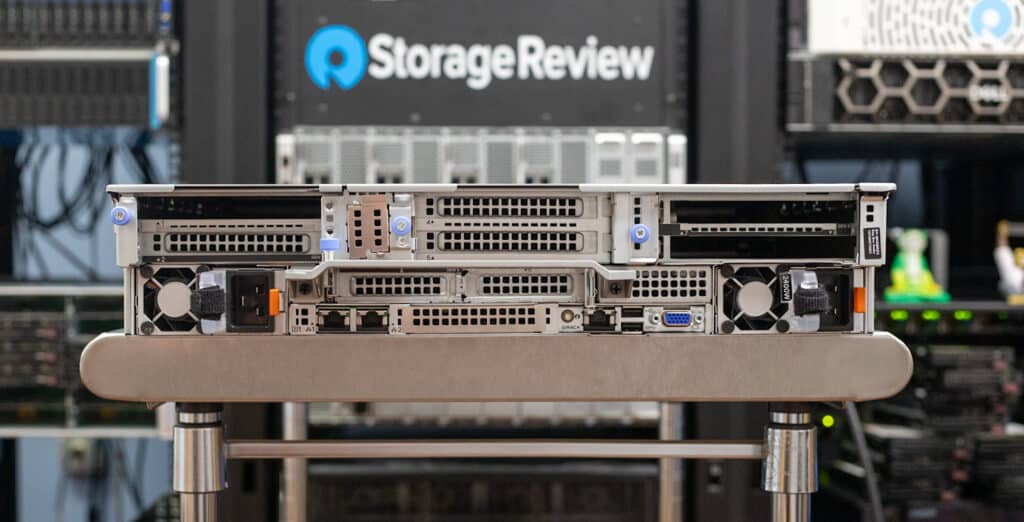
Under the hood, we see an intelligent and roomy design. At the front are the drive bays and backplane next to a bank of cooling fans. These are crucial for maintaining airflow over the heat-generating components, and this setup certainly looks like it will dissipate heat and keep the server operating within safe temperature thresholds.
In the middle of the motherboard lies the CPU, which is the AMD EPYC 9354 processor. On either side of the CPU/heat sink are 12 DDR5 DIMM slots (which support up to RDIMM 3TB and speeds up to 4800 MT/s). In our case, we have just 16GB of RAM.
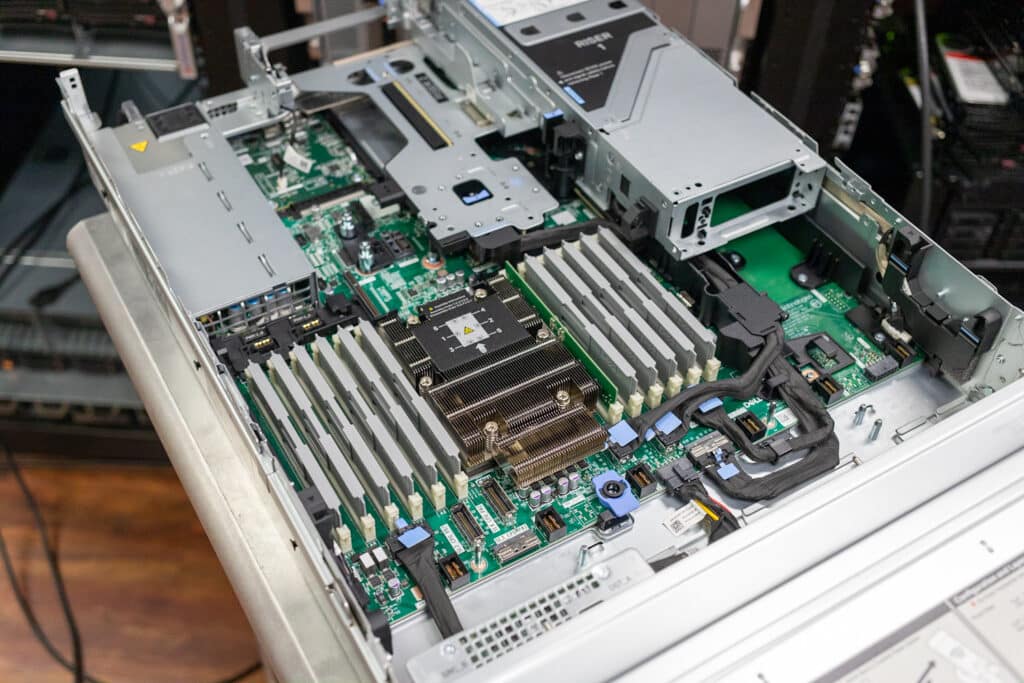
Moving on to the expansion slots, you’ll see 2 x8 Full-Height slots, 2 x16 Low-Profile slots, and 2 x16 Double-Width slots, all supporting PCIe Gen5. This variety allows for a wide range of expansion cards, giving you the flexibility to add anything from additional network cards to high-end storage controllers.
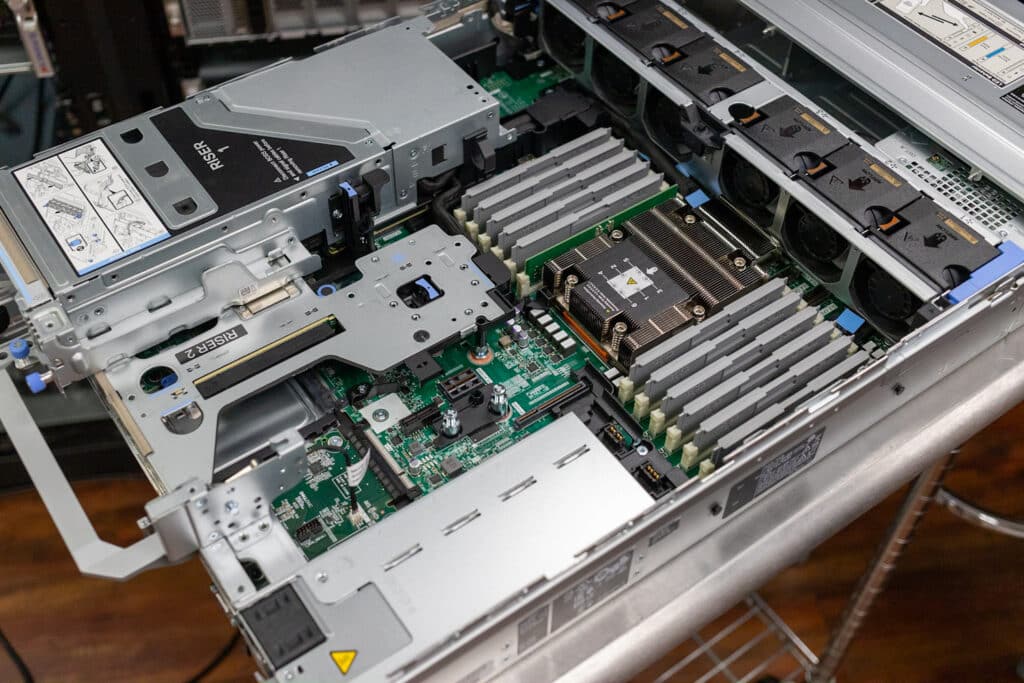
Looking at the power supply units, the PowerEdge R7615 offers a range of choices. Depending on the power requirements of your specific build, you can opt for single or dual, hot-plug, and fully redundant power supplies with wattages that can go up to 2400W. This versatility ensures that the server can be tailored to meet specific power needs, which is crucial for high-performance setups.
Dell PowerEdge R7615 Performance
As we indicated above, our Dell PowerEdge R7615 server configuration is as basic as you can get. This means we don’t expect a lot in the way of performance during our benchmarking. The R7615 system for our review features an AMD EPYC 9354 processor (3.25GHz, 32 cores/64 threads, 256M Cache) and 16GB of DDR5 RAM.
Although the server is built to handle dual GPUs, our system has none. It is also limited on DRAM, so we have tailored our benchmarking approach to focus on tests that heavily leverage CPU capabilities, which means we won’t conduct benchmarks such as ESRI, Luxmark, SPECworkstation 3, 7zip, and SPECviewperf 2020. Instead, our evaluation will concentrate on benchmarks that primarily stress the CPU to show its performance in compute-intensive tasks clearly.
Blender OptiX
First up is the Blender test–an open-source 3D modeling application. This benchmark was run using the Blender Benchmark utility. The score is samples per minute, with higher being better.
| Dell PowerEdge R7615 (AMD EPYC 9354P, 32 cores, 3.25GHz) |
HPE ProLiant DL320 (Intel 4th Gen Xeon-G 6430 CPU (32 cores, 3.7 GHz max)) | |
| Blender OptiX Version 3.6 (CPU) (Samples per minute; Higher is better) | Score | Score |
| Monster | 397 | 279 |
| Junkshop | 245 | 177 |
| Classroom | 200 | 135 |
In our benchmarking tests using Blender OptiX Version 3.6, the basic configuration of the Dell PowerEdge R7615, featuring an AMD EPYC 9354P processor and 16GB of DDR5 RAM, yielded modest results. The server scored 397 samples per minute on the ‘Monster’ test, 245 samples per minute on ‘Junkshop,’ and 200 samples per minute on ‘Classroom’.
| Blender OptiX Version 4.0 (CPU) (Samples per minute; Higher is better) | Dell PowerEdge R7615 (AMD EPYC 9354P, 32 cores, 3.25GHz) |
HPE ProLiant DL320 (Intel 4th Gen Xeon-G 6430 CPU (32 cores, 3.7 GHz max)) |
| Monster | 375 | 952 |
| Junkshop | 248 | 613 |
| Classroom | 198 | 437 |
In the version 4.0 benchmarking, the Dell PowerEdge R7615 server achieved 375 samples per minute in the ‘Monster’ test, 248 samples per minute in ‘Junkshop,’ and 198 samples per minute in ‘Classroom’. These results reflect a steady rendering capability, aligning closely with the performance observed in the previous Blender version.
Blackmagic RAW Speed Test
We have also started running Blackmagic’s RAW speed test, which tests video playback performance. Additionally, this test is more of a hybrid test pooling both CPU and GPU in a Real-World scenario for RAW decoding.
| Blackmagic RAW Speed Test (Higher is better) | Dell PowerEdge R7615 (AMD EPYC 9354P, 32 cores, 3.25GHz) |
HPE ProLiant DL320 (Intel 4th Gen Xeon-G 6430 CPU, 32 cores, 3.7 GHz max) |
| 8K CPU | 59 | 99 FPS |
| 8K CUDA | N/A | N/A |
The HPE ProLiant DL320 demonstrated modest performance in the Blackmagic RAW Speed Test. In video playback and RAW decoding scenarios, it achieved just 59 FPS in the 8K CPU test. Since this server lacks a GPU, this test’s 8K CUDA portion was not evaluated.
Geekbench 6
Geekbench 6 is a cross-platform benchmark that measures overall system performance. However, looking at the single-core vs. multi-core and the OpenCL benchmark would be interesting. Higher scores are better. Again, we only looked at the CPU results, as no GPU is installed inside this server.
You can find comparisons to any system you want in the Geekbench Browser.
| Geekbench 6 | Dell PowerEdge R7615 (AMD EPYC 9354P, 32 cores, 3.25GHz) |
HPE ProLiant DL320 (Intel 4th Gen Xeon-G 6430 CPU, 32 cores, 3.7 GHz max) |
| CPU Benchmark – Single-Core | 2,070 | 1,732 |
| CPU Benchmark – Multi-Core | 12,049 | 12,792 |
| GPU Benchmark – OpenCL | N/A | N/A |
Cinebench R23
Maxon’s Cinebench R23 is a CPU rendering benchmark that utilizes all CPU cores and threads. We ran it for both multi- and single-core tests. Higher scores are better.
| Cinebench R23 | Dell PowerEdge R7615 (AMD EPYC 9354P, 32 cores, 3.25GHz) |
HPE ProLiant DL320 (Intel 4th Gen Xeon-G 6430 CPU, 32 cores, 3.7 GHz max) |
| CPU (Multi-Core) (Points) | 52,401 | 38,707 |
| CPU (Single-Core) (Points) | 1,343 | 1,245 |
| MP Ratio | 39.03x | 31.10x |
Cinebench 2024
Here are the results for the 2024 version of Cinebench, looking at the CPU and GPU performance.
| Cinebench R23 | Dell PowerEdge R7615 (AMD EPYC 9354P, 32 cores, 3.25GHz) |
HPE ProLiant DL320 (Intel 4th Gen Xeon-G 6430 CPU, 32 cores, 3.7 GHz max) |
| CPU (Multi-Core) (Points) | 2,127 | 2,014 |
| CPU (Single-Core) (Points) | 83 | 71 |
| MP Ratio | 25.61x | 28.29x |
y-cruncher
y-cruncher is a multi-threaded and scalable program that can compute Pi and other mathematical constants to trillions of digits. Since its launch in 2009, y-cruncher has become a popular benchmarking and stress-testing application for overclockers and hardware enthusiasts. Faster is better in this test.
| y-cruncher (Total Computation time) |
Dell PowerEdge R7615 (AMD EPYC 9354P, 32 cores, 3.25GHz) |
HPE ProLiant DL320 (Intel 4th Gen Xeon-G 6430 CPU, 32 cores, 3.7 GHz max) |
| 1 billion digits (Seconds) | 36.686 | 21.452 |
| 2.5 billion digits (Seconds) | 98.68 | 50.418 |
| 10 billion digits (Seconds) | 131.135 |
In the y-cruncher benchmark, designed to test computational performance, our Dell PowerEdge R7615 build showcased its capabilities in number crunching. It completed the computation of 1 billion digits in 36.686 seconds and took 98.68 seconds to process 2.5 billion digits. These times reflect the server’s modest proficiency in handling intensive computational tasks, demonstrating solid performance for its basic configuration.
UL Procyon AI Inference (CPU)
UL’s Procyon AI Inference benchmark suite tests how various AI inference engines perform using state-of-the-art neural networks. We run these tests on the CPU only. The numbers below are average inference times; the overall score is the last row.
| Test | Dell PowerEdge R7615 (AMD EPYC 9354P, 32 cores, 3.25GHz) |
| MobileNet V3 | 4.27 |
| ResNet 50 | 18.39 |
| Inception V4 | 70.70 |
| DeepLab V3 | 59.17 |
| YOLO V3 | 84.89 |
| REAL-ESRGAN | 5233.51 |
| Overall Score | 68 |
The Dell PowerEdge R7615 demonstrated varied performance across different neural network tests. For example, it completed the MobileNet V3 test in 4.27 seconds, while the more complex Inception V4 test took 70.70 seconds. The server showed a longer processing time of 5233.51 seconds in the REAL-ESRGAN test, highlighting the varying demands of different AI models on computational resources. Overall, the R7615 scored 68, indicating its capability to handle some AI inference tasks, albeit with varied efficiency across different AI models.
Conclusion
The Dell PowerEdge R7615 server emerges with huge potential based on its customization options and strong player in the server technology market, blending cost-effectiveness with robust performance capabilities. As a 2U single-socket server, it supports new 4th Generation AMD EPYC 9004 Series processors, with options ranging from 16 to 128 cores. It also can be outfitted with up to 3TB of DDR5 RAM, which significantly boosts its data processing and multitasking abilities, making it an ideal choice for businesses requiring high processing power.
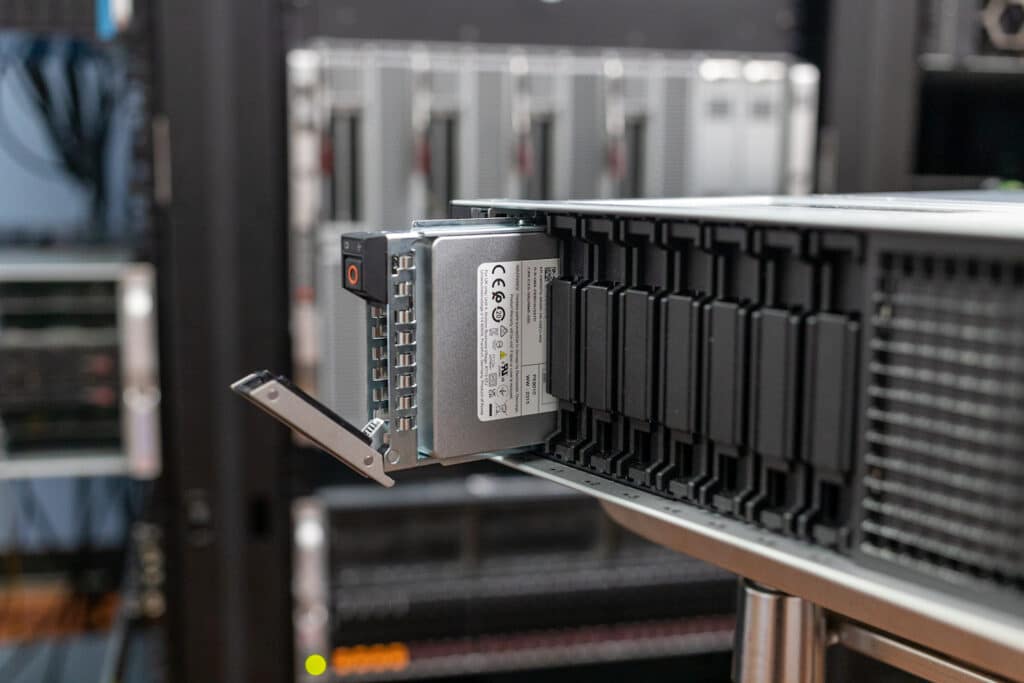
Storage solutions are equally comprehensive, with the server supporting up to 368.64TB through multiple drive bays that accommodate HDD, SSD, and NVMe drives. Options like air cooling, Direct Liquid Cooling, and various power supply choices further enhance this adaptability. The inclusion of Dell’s iDRAC9 for server management adds to its appeal, offering advanced control and monitoring capabilities. This variety ensures that it can cater to various performance needs.
Powered by a lower-end AMD EPYC 9354P 32-core processor and 16GB of RAM, the server performed as adequately as possible across various benchmarks. However, it’s important to note that this is just the baseline performance, and with higher-end configurations, the server is expected to deliver significantly better results. So, because of this basic entry-level configuration, having an overall opinion on performance is a bit tricky. We expect massive potential from the server when handling more intensive computing and graphical tasks when outfitted with more robust configurations that feature higher-end CPUs and multiple GPUs.
Overall, the Dell PowerEdge R7615 presents itself as a server with great potential for scalability and customization. It offers a strong foundation that can be built upon to meet a wide range of computing needs, from basic to highly demanding tasks. While the entry-level performance may be modest, the server’s design and capabilities certainly hint at significant improvements with higher-end configurations. This makes the R7615 a versatile and promising choice for various enterprise environments, particularly for those who require a server that can evolve alongside their growing computing needs.




 Amazon
Amazon